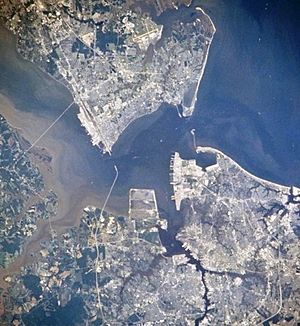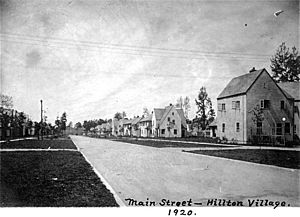History of Newport News, Virginia facts for kids

Newport News has a long and interesting history. It dates back to the early days of Jamestown, Virginia, one of the first English settlements in America. Over time, the area that is now Newport News has had different names, like Elizabeth Cittie and Warwick County. Today, it is known as the independent city of Newport News.
Contents
Early Days: From Elizabeth Cittie to Warwick County
In the 1600s, soon after Jamestown was founded in 1607, English settlers began moving into the areas around Hampton Roads. In 1610, Sir Thomas Gates took over a nearby Native American village. This village later became known as Kecoughtan.
By 1619, the Newport News area was part of a large land grant from the Virginia Company of London. This area was called Elizabeth Cittie. It stretched west to Skiffe's Creek, which is now the border between Newport News and James City County.
Around 1634, the English colony of Virginia had about 5,000 people. It was divided into eight areas called "shires." These shires were soon renamed as counties. The Newport News area became part of Warwick River Shire, which turned into Warwick County in 1637.
Early Warwick County was mostly made up of farms and large plantations. These lands were given to settlers. Some famous old places included Newport News Farm, Bolthorpe, and Denbigh Plantation. In 1704, there were only 125 properties recorded in Warwick. Some of these old homes, like Bourbon and Endview, are still standing today.
Daniel Gookin arrived in 1621 and was the first person known to own land in Newport News. His land was huge, over 1,600 acres (6.5 km2). It ran along the James River. Captain John Smith had noted that this land had a good spring for fresh water. Ships would stop there to refill their water supplies. Gookin's land was later divided into several farms.
How a Small Village Became a Big City (1881-1896)
Newport News was just a small farming and fishing village for many years. But this changed when the railroad arrived and a large shipyard was built.
Collis P. Huntington visited Newport News Point when he was 16 years old in 1837. He later became very rich by helping to build the first transcontinental railroad in the western United States. He also helped finish a railroad line from the James River to the Ohio River in 1873.
This new railroad, the Chesapeake and Ohio Railway (C&O), helped transport a lot of coal from West Virginia. However, the James River at Richmond was too shallow for big ships carrying coal. So, a deepwater port was needed.
The C&O solved this problem by extending its railway line about 75 miles (121 km) east from Richmond to Newport News Point. This new line opened in late 1881. It created an important path for West Virginia coal to reach the deep harbor of Hampton Roads. From there, the coal could be shipped all over the world.
Newport News grew a lot because of the C&O railroad. The Chesapeake and Ohio Railway became one of the richest railroads in the country. By 1915, Hampton Roads was the largest coal export point in the world. This was thanks to the C&O and other railroads like the Norfolk and Western Railway.
Collis P. Huntington and his partners started developing the small community at Newport News Point. His Old Dominion Land Company built the famous Hotel Warwick, which opened in 1883. This hotel was very important for the city's growth. It was the main center for business and community life in the early years. The first bank, newspaper, post office, and even the local government were all in the Hotel Warwick for a time.
In 1896, Newport News officially became an independent city. This meant it was separate from Warwick County. Walter A. Post became the city's first mayor.
Newport News in the 20th Century: Two World Wars
In the early 1900s, the leaders of Newport News and the shipyard were often the same people. Walter A. Post, the first mayor, also became president of the shipyard.
In 1914, Albert L. Hopkins, a young engineer, took over the shipyard. He died in 1915 when the RMS Lusitania ship was sunk by a German U-boat. This event, where 127 Americans died, helped bring the United States into World War I. During the war, the shipyard built many destroyer ships.
Homer L. Ferguson is another important leader from this time. He took over as shipyard president after Albert Hopkins died. He led the company through both World War I and World War II.
As World War I approached in 1917, Ferguson played a big part in creating Hilton Village. This community was built to house shipyard workers. It was one of the first planned communities in the country. The planners even talked to the workers' wives to design the homes. After the war, the homes were sold to shipyard employees and other local residents. Hilton Village became the first important suburb in Warwick County.
After World War I, the shipyard started building aircraft carriers. The Ranger was delivered in 1934. The shipyard continues to build aircraft carriers today. Homer Ferguson retired in 1946, after World War II ended. He also helped start the Mariners' Museum with Archer M. Huntington and his wife, Anna Hyatt Huntington.
Joining with Warwick County
After the fast growth during and after World War II, many cities in the Hampton Roads area started to combine. Being an "independent city" protects a city from being taken over by nearby communities. In 1952, Warwick County became the independent city of Warwick.
Then, in 1958, the people of Warwick and Newport News voted to combine their two cities. They chose to keep the name Newport News because it was more well-known. This made Newport News the third-largest city in Virginia by population. The city's borders today are mostly the same as the original Warwick County.
The Huntington Family's Impact
The Huntington family played a big role in Newport News. After Collis P. Huntington died, his nephew, Henry E. Huntington, took over leadership of the shipyard. Huntington Park, built after World War I, is named after him.
Collis Huntington's son, Archer Milton Huntington, and his wife, Anna Hyatt Huntington, started the Mariners' Museum in 1932. They created a natural park and Mariners' Lake there. The Mariners' Museum has grown to be one of the largest and best maritime museums in the world.
Newport News City Song
In 1989, the Newport News City Council chose "Newport News" as the city's official song. It was written by Ronald W. Bell, who was born in the city. The song talks about the city's connection to America's early history and its long tradition of shipbuilding.
Newport News
Harbor of a thousand ships
Forger of a nation's fleet
Gateway to the New World
Where ocean and river meet
Strength wrought from steel
And a people's fortitude
Such is the timeless legacy (chorus)
Of a place called Newport News
Nestled in a blessed land
Gifted with a special view
Forever home for ev'ry man
With a spirit proud and true
(repeat chorus)


